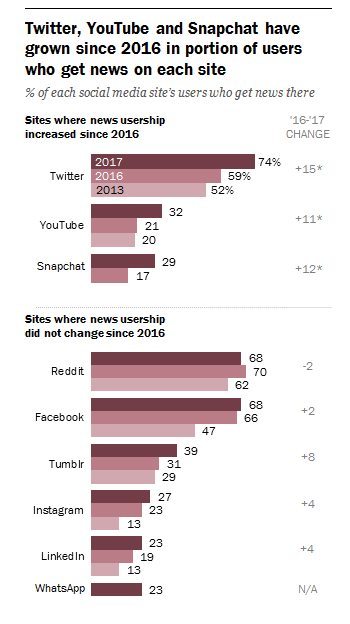
Sixty-seven percent of Americans report getting some of their news via social media at some point, according to a Pew Research survey of just under 5,000 U.S. adults conducted last month and published Thursday.
That overall percentage is only up slightly from 62 percent in 2016, in the run-up to the November election. But among specific demographics, using social media for news has increased: 74 percent of non-white U.S. adults now get news from social media, up from 64 percent of that group who got news that way in 2016. Fifty-five percent of Americans 50 and older say they’ve gotten news from social media, up from 45 percent (older people are also driving the increasing percentage of people who get news via mobile).Facebook is still the dominant social media source for news. But when Pew looked at the percentage of users on each social media platform who were using it for news, it was Twitter, Snapchat, and YouTube that saw increases (remember that user bases are vastly different sizes, from YouTube to Facebook to Tumblr to Twitter):

— In 2017, 74 percent of Twitter users said they got news from Twitter, up 15 percent from last year, possibly thanks to President and tweeter-in-chief Donald Trump, who has taken to making official U.S. policy statements there.
— 32 percent of YouTube users report getting news there, up from 21 percent last year.
— 29 percent of Snapchat users now report using it for news, up from 17 percent in 2016. This should be a welcome number for all the publishers investing massively in Snapchat Discover.
The study also looked at the demographics of users who access news on these platforms. Snapchat, unsurprisingly, has the youngest user base consuming news there. It, along with Instagram, also has the largest share of non-white users among the social media channels the Pew study looked at:

The full report is available here.